EECS 31/CSE 31/ICS 151 Homework 2 Questions with Solutions
View Questions Only
View Questions with Strategies
Problem 1
Question
(Theorems of Boolean algebra) Give proofs to the following theorems.
- Theorem 3(a) and (b)
- Theorem 6(a) and (b)
Solution
-
Theorem 3(a) and (b)
THEOREM 3(a) Law of Absorption : yx+x = x.
Proof :
yx+x = yx+x1 by identity (Ax. 2b) = x(y+1) by distributivity (Ax. 4a) = x1 by Theorem 2(a) = x by identity (Ax. 2b)THEOREM 3(b): x(x+y) = x by duality.
-
Theorem 6(a) and (b)
THEOREM 6(a) De Morgan's Laws: (x+y)' = x'y'.
Proof: We will prove that x'y' is a complement of x+y by proving that x'y' satisfies Axiom 5, which states that x+x' = 1 and that xx' = 0. Thus we have to prove that (a) (x+y)+(x'y')=1 and (b) (x+y)(x'y') = 0.
Part (a):
(x+y)+(x'y') = x+(y+(x'y')) by assiociativity (Th. 5a) = x+((x'y')+y') by commutativity (Ax. 3a) = (x+(x'y'))+y by assiociativity (Th. 5a) = (x+x')(x+y')+y by distributivity (Ax. 4b) = 1(x+y')+y by complement (Ax. 5a) = (x+y')+y by identity (Ax. 2b) = x+(y'+y) by assiociativity (Th. 5a) = x+1 by complement(Ax. 5a) = 1 by Theorem 2(b)Part (b):
(x+y)(x'y') = x(x'y')+y(x'y') by distributivity (Ax. 4a) = x(x'y')+y(y'x') by commutativity (Ax. 3b) = (xx')y'+(yy')x' by associativity (Th. 3b) = 0y'+0x' by complement(Ax. 5b) = 0+0 by identity(Ax. 2b) = 0THEOREM 6(b): (xy)' = x'+y' by duality.
Problem 2
Question
(Theorems and proofs) Using truth tables, prove the validity of the following identies.
- (xyz)' = x'+y'+z'
Solution
| x y z | (xyz)' | x' | y' | z' | x'+y'+z' |
|---|---|---|---|---|---|
| 0 0 0 | 1 | 1 | 1 | 1 | 1 |
| 0 0 1 | 1 | 1 | 1 | 0 | 1 |
| 0 1 0 | 1 | 1 | 0 | 1 | 1 |
| 0 1 1 | 1 | 1 | 0 | 0 | 1 |
| 1 0 0 | 1 | 0 | 1 | 1 | 1 |
| 1 0 1 | 1 | 0 | 1 | 0 | 1 |
| 1 1 0 | 1 | 0 | 0 | 1 | 1 |
| 1 1 1 | 0 | 0 | 0 | 0 | 0 |
Problem 3
Question
(Boolean functions) Derive truth tables for the following Boolean functions.
- F(x, y, z) = (x+z)'
- F(x, y, z) = (x+z)'(x+y')
Solution
-
F(x, y, z) = (x+z)'
x y z x+z (x+z)' 0 0 0 0 1 0 0 1 1 0 0 1 0 0 1 0 1 1 1 0 1 0 0 1 0 1 0 1 1 0 1 1 0 1 0 1 1 1 1 0 -
F(x, y, z) = (x+z)'(x+y')
x y z (xyz)' x+y' (x+z)'(x+y') 0 0 0 1 1 1 0 0 1 0 1 0 0 1 0 1 0 0 0 1 1 0 0 0 1 0 0 0 1 0 1 0 1 0 1 0 1 1 0 0 1 0 1 1 1 0 1 0
Problem 4
Question
(Boolean algebra) Prove by algebraic manipulation that the following expressions are equivalent.
- x'y'+xy = (xy'+x'y)'
- x'z+xy = x'y'z+yz+xy
Solution
-
(xy'+x'y)' = (xy')'(x'y)' De Morgan's = (x'+y)(x+y') De Morgan's = x'x+x'y'+xy+yy' distributivity = x'y'+xy identity -
x'z+xy = x'z+xy+xy idempotency = x'z(y+y')+xy(z+z')+xy identity = x'yz+x'y'z+xyz+xyz'+xy distributivity = x'y'z+(x+x')yz+xy distributivity = x'y'z+yz+xy identity
Problem 5
Question
(Algebraic manipulation) Minimize the number of operators in the following Boolean expressions.
- x'y'+xy+xy'
- (x+y)(x+y')
Solution
- x+y'
- x
Problem 6
Question
(Boolean implementations) Implement the XOR function by means of:
- NAND gates only
- NOR gates only
- AND, OR, and NOT gates
Solution

Problem 7
Question
(Boolean implementations) Implement x XOR y XOR z using the components in the basic logic library presented in Table 3.14. Find the implementation that has:
- The smallest cost
- The shortest delay
Solution
Notice that XNOR has the smallest delay. Therefore, we first try using the XNOR implementation.
F = x XOR y XOR z = (x XOR y)z' + (x XOR y)'z by definition of XOR = (xy' + x'y)z' + (xy' + x'y)'z by definition of XOR = xy'z' + x'yz' + (xy' + x'y)'z by distributivity = xy'z' + x'yz' + (x' + y)(x + y')z by De Morgan's law = xy'z' + x'yz' + (x'x + x'y' + xy + yy')z by distributivity = xy'z' + x'yz' + (x'y' + xy)z by complement = xy'z' + x'yz' + x'y'z + xyz by distributivity = (xy' + x'y)z' + (x'y' + xy)z by distributivity = (xy + x'y')'z' + (x'y' + xy)z by complement = x XNOR y XNOR z by definition of XNOR
The solutions for (a), (b) and (c) are the same:

Cost = 12 + 12 = 24 Delay = 3.2 + 3.2 = 6.4
Problem 8
Question
(Logic Libraries) Using the basic logic library presented in Table3.14, implement the full subtractor that is specified by the following table:
Xi Yi Bi | Bi+1 Di ------------------------------ 0 0 0 | 0 0 0 0 1 | 1 1 0 1 0 | 1 1 0 1 1 | 1 0 1 0 0 | 0 1 1 0 1 | 0 0 1 1 0 | 0 0 1 1 1 | 1 1
Find the implementation that has:
- The smallest cost
- The shortest delay
Solution
-
The smallest cost using NAND gates
Bi+1 = x'y'b + x'yb' + x'yb + xyb by definition = x'(y'b + yb') + yb(x'+x) by distributivity = x'(y'b + yb') + yb by complement = x'((y'b)' (yb')')' + yb by De Morgan's law = ((x' ((y'b)' (yb')')')' (yb)' )' by De Morgan's law Di = x'y'b + x'yb' + xy'b' + xyb by definition = x'(y'b + yb') + x(yb + y'b') by distributivity = x'((y'b)'(yb')')' + x((yb')(y'b')')' by De Morgan's law = ((x'((y'b)' (yb')')')' (x((yb') (y'b')')')')' by De Morgan's law
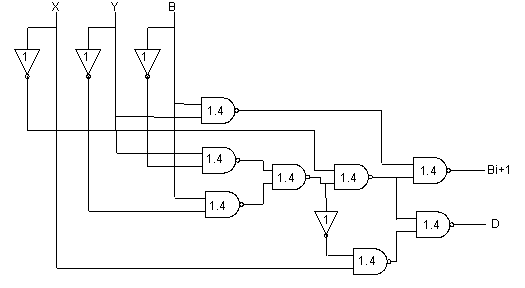
Cost = 4 x 8 + 2 x 4 = 40 Delay = 1 x 2 + 1.4 x 4 = 7.6
-
The shortest delay
Bi+1 = x'y'b + x'yb' + x'yb + xyb by definition = b(xy + x'y') + x'y(b'+b) by distributivity = (b((xy)' (x'y')' )' + x'y by complement = ((b((xy)' (x'y')')')' (x'y)')' by De Morgan's law Di = x'y'b + x'yb' + xy'b' + xyb by definition = x'(x'y + xy') + b(xy + x'y') by distributivity = b'((x'y)'(xy'))' + b((xy)'(x'y')')' by De Morgan's law = ((b'((x'y)' (xy'))')' (b((xy)' (x'y')')')' )' by De Morgan's law
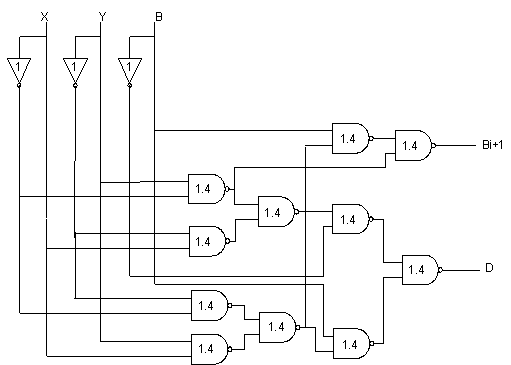
Cost = 2 x 3 + 4 x 11 = 50 Delay = 1 + 1.4 x 4 = 6.6
Problem 9
Question
(Logic Libraries) Redo Problem 3.15 using only the gates that are given in Table 3.15 and 3.16
Solution
-
The smallest cost
F = (xy' + x'y)z' + (xy' + x'y)'z by XOR definition = ((xy' + x'y)' + z)' + (xy' + x'y)'z by De Morgan's law
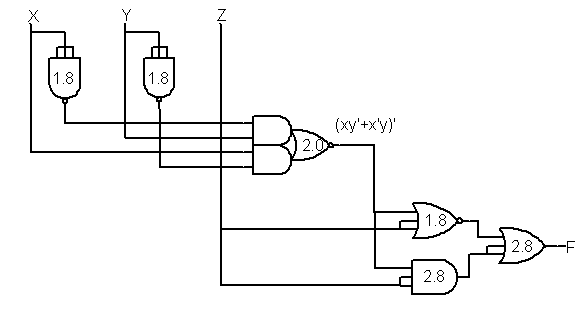
Cost = 6x8 = 48 Delay = 1.8 + 2.0 + 2.8 + 2.8 = 9.4
-
The shortest delay and the smallest cost-delay product
F = xyz + x'y'z + x'yz' + xy'z' by XOR definition = ((xyz + x'y'z + x'yz' + xy'z')')' by involution = ((xyz)' (x'y'z)' (x'yz')' (xy'z')')' by De Morgan's law
OrF = (x + y + z) (x + y' + z') (x' + y + z')(x' + y' + z) by definition = (((x + y + z) (x + y' + z') (x' + y + z') (x' + y' + z))')' by involution = ((x + y + z)' + (x + y' + z')' + (x' + y + z')' + (x' + y' + z)')' by De Morgan's law

Cost = 7 x 8+10 = 66 Delay = 1.8 + 1.8 + 2.2 = 5.8 Cost x Delay = 382.8
Problem 10 (3.18)
Question
(Logic Libraries) Redo Problem 3.15 using any of the standard logic gates that are given in Table 3.14, 3.15 and 3.16
Solution
-
The smallest cost and the smallest cost-delay product
F = x XOR y XOR z = x XNOR y XNOR z by problem 3.15
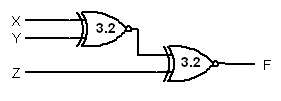
Cost = 2 x 12 = 24 Delay = 2 x 3.2 = 6.4 Cost x Delay = 153.6
-
The shortest delay
F = ((xyz)' (x'y'z)' (x'yz')' (xy'z')')' by problem 3.17
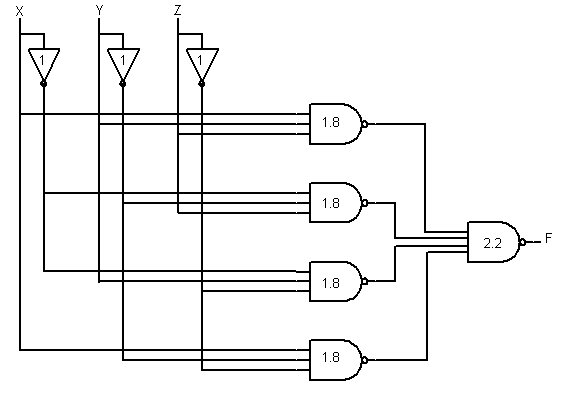
Cost = 3 x 2 + 4 x 8 + 10 = 48 Delay = 1.0 + 1.8 + 2.2 = 5.0 ns
Problem 11 (3.19)
Question
(Gate arrays) Using a 3-input NAND gates, derive a logic schematic of a:
- full adder
- full subtractor
Solution
-
Full Adder
-
Write the truth table for the full adder.
Xi Yi Ci | Ci+1 Si ------------------------- 0 0 0 | 0 0 0 0 1 | 0 1 0 1 0 | 0 1 0 1 1 | 1 0 1 0 0 | 0 1 1 0 1 | 1 0 1 1 0 | 1 0 1 1 1 | 1 1
-
Write out sum of product expression of this truth table.
Ci+1 = Xi'YiCi + XiYi'Ci + XiYiCi' + XiYiCi = YiCi + XiCi + XiYi Si = Xi'Yi'Ci + Xi'YiCi' + XiYi'Ci' + XiYiCi
-
Convert this expression into format with no more than 3 operator sub-expression or 3 literals. If the expressions contain more than 3 operators or literals, group them into 3-input operator.
Ci+1 = YiCi + XiCi + XiYi = (YiCi)' (XiCi)' (XiYi)')' Si = Xi'Yi'Ci + Xi'YiCi' + XiYi'Ci' + XiYiCi = (((Xi'Yi'Ci)' (Xi'YiCi')' (XiYi'Ci')')'' (XiYiCi)')'
-
Represent this two expression with 3-input NAND gates.

Cost = 6 x 14 = 84 Delay: Input to Si = 1.8 x 5 = 9.0 Input to Ci+1 = 1.8 x 3 = 5.4
-
Write the truth table for the full adder.
-
Full Subtractor
-
Write the truth table of full subtractor.
Xi Yi Bi | Bi+1 Di ------------------------- 0 0 0 | 0 0 0 0 1 | 1 1 0 1 0 | 1 1 0 1 1 | 1 0 1 0 0 | 0 1 1 0 1 | 0 0 1 1 0 | 0 0 1 1 1 | 1 1
-
Write out sum of product expression of this truth table.
Bi+1 = Xi'Yi'Bi + Xi'YiBi' + Xi'YiBi + XiYiBi Di = Xi'Yi'Bi + Xi'YiBi' + XiYi'Bi' + XiYiBi
-
Convert this expression into format with no more than 3 operator sub-expression or 3 literals. If the expressions contain more than 3 operators or literals, group them into 3-input operator.
Bi+1 = Xi'Yi'Bi + Xi'YiBi' + Xi'YiBi + XiYiBi = (((Xi'Yi'Bi)' (Xi'YiBi')' (XiYiBi)')'' (Xi'YiBi)')' Di = Xi'Yi'Bi + Xi'YiBi' + XiYi'Bi' + XiYiBi = (((Xi'Yi'Bi)' (Xi'YiBi')' (XiYiBi)')'' (XiYi'Bi')')'
-
Represent this two expression with 3-input NAND gates.

Cost = 6 x 12 = 72 Delay: Input to Di = 1.8 x 5 = 9.0 Input to Bi+1 = 1.8 x 5 = 9.0
-
Write the truth table of full subtractor.